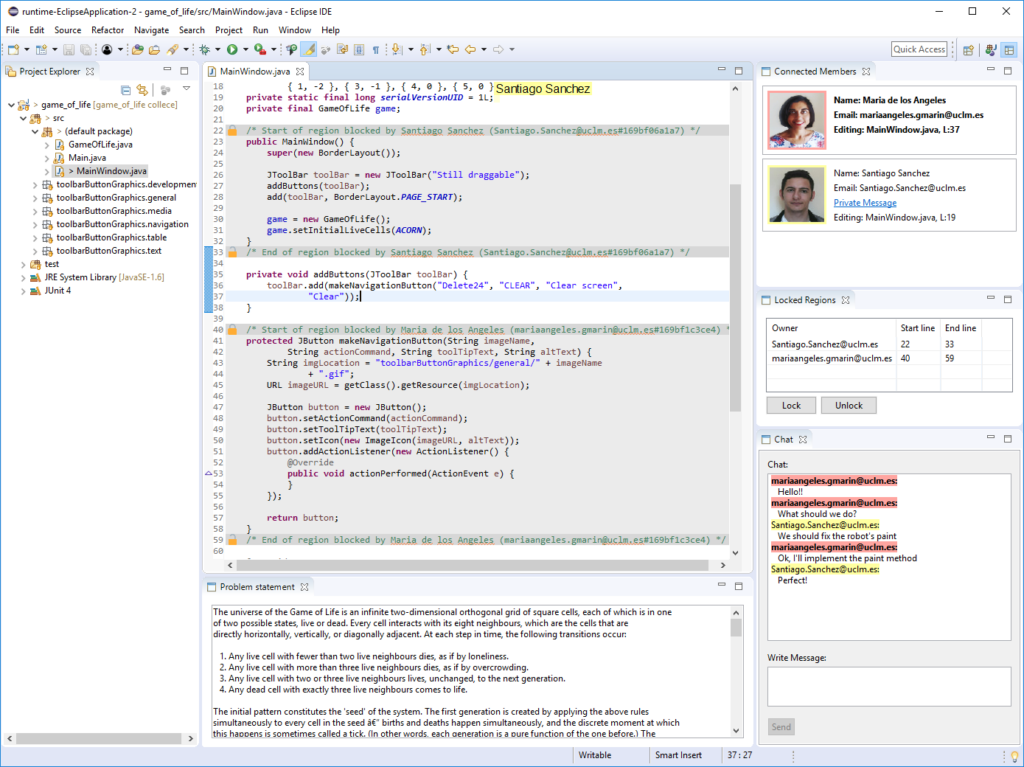Latest news
What is COLLECE-2.0?

COLLECE-2.0 (COLLaborative Edition, Compilation and Execution of programs) is an Eclipse plugin that provides a set of features that facilitate the learning of programming through the participation and remote asynchronous collaboration of users when faced with a proposed problem.
These features allow users to be aware of the environment that surrounds them within Eclipse at any time and cooperate with each other to finally obtain a functional solution to the problem, as well as learn from what they see their peers do.
With this approach, COLLECE-2.0 incorporates the following features:
- Modular. The tool is easily installed as a plugin through the Eclipse repository system. Thanks to this, the tool provides robust extensibility through other plugins.
- Work sessions. The way to organize the work with the tool is based on sessions where multiple users connect and work simultaneously. These sessions are directly associated with a programming problem to be solved and can be created by any user.
- Multi-user edition. So that several users can concurrently edit the same files, COLLECE-2.0 provides a low-latency, real-time collaborative editing system that allows for smooth editing.
- Telepointers. Users must know at all times who is editing which section of the file. Telepointers provide this information through coloured regions associated with a user.
- Region blocking. Preventing other users from modifying sections of code within a file, prevents conflicts and improves coordination between users. Locking regions allows this by shading lines of code that are locked and therefore belong to a user.
- Chat. The tool provides an instant messaging mechanism that identifies the users participating in the session by color and name. This communication can be public (to all members of the session) or private (to a specific user).
- Version control systems. COLLECE-2.0 makes intensive use of repository systems to persistently maintain the status of code projects associated with sessions. Users benefit directly from this by being able to share any remote repository (for example, from a provider such as Bitbucket or GitHub) in a work session with other users.
The environment also provides support for other plugins or tools, thus extending the initial capabilities of COLLECE-2.0, which can be found at the following links:
Install
Download the latest version of Eclipse in its Eclipse IDE for Java Developers flavour. Once installed, the following steps must be performed:
- In Eclipse, go to Help -> Install New Software…
- Click on the Add button to the right.
- Type a name in the text box. For example: COLLECE-2.0
- Paste the following URL into the Location field:
http://www.esi.uclm.es/www/santiago.sanchez/iapro/collece-2.0-plugin/
- Finally, select and install the COLLECE-2.0 category.
NOTE: The last version tested was the 2019-03 R, so its use is recommended for an optimal experience.
Quick user guide
The tool allows to work in server mode and client mode. You need a server that maintains the database and work sessions to work.
To deploy the server, the user simply has to go to File -> New -> Other… and select COLLECE-2.0 -> Server. Then select the directory where COLLECE-2.0 will store the configuration and information associated with the server, and the listening port of the clients. Finally, finish the wizard to have the COLLECE-2.0 server running.
Note: in case the server is behind a NAT service and wants to work over the Internet, the users must redirect the selected port to the IP address of their computer in the router.
To connect to a COLLECE-2.0 server and start working on a session, the user must go to File -> New -> Other… and select COLLECE-2.0 -> Client. In the first view of the wizard, the users can log in or sign in to the server if they has not done so before. Once logged in with the user’s data, the user must choose a working session and join it by clicking on the Join button. Then, finish the wizard.
[ Back ]

